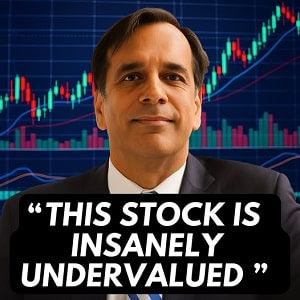In 2025, the energy sector has surpassed the overall market, as evidenced by the S&P 500 Energy ETF (XLE) rising more than 7%, fueled by skyrocketing natural gas prices.
Recommended:

Last year, one Wall Street veteran warned we were in the early days of a massive shift playing out in U.S. stocks – one we’ve only seen a dozen times before, going all the way back to 1943 – and that it would soon impact every major stock you could think of, especially Nvidia… He was right. Now, he’s sharing where the stock market’s likely going next… what it could mean for your money in 2025… and the No. 1 investing strategy he’s now recommending if you want the chance to protect and grow your wealth over the next five to 10 years.
Natural Gas Surge Powers Energy Stocks in 2025
The energy sector has outperformed the broader market in 2025, with the S&P 500 Energy ETF (XLE) up over 7%, driven by soaring natural gas prices. Cold weather, increased LNG exports, and higher electricity demand have fueled this rise. According to Louis Navellier, the Trump-era push to deregulate the industry and boost natural gas exports has significantly benefited pipeline and midstream companies.
Plains All America Pipeline (PAA), Baker Hughes (BKR), and MPLX (MPLX) are among the biggest gainers, up 19%, 13%, and 12% year-to-date, respectively. Traditional oil and gas giants like ExxonMobil (XOM) and Chevron (CVX) have seen more modest gains, while BP (BP) is up 17% as it shifts focus back to oil and gas amid pressure from activist investors.
Capital discipline has been a key theme, with companies producing more efficiently and returning cash to shareholders through stock buybacks and dividend hikes. Devon Energy (DVN), for instance, raised its quarterly dividend by 9% after strong fourth-quarter results.
However, risks remain, particularly with the upcoming shift into spring, which will reduce heating demand, and potential geopolitical shifts, such as a resolution in the Russia-Ukraine conflict, which could ease supply constraints. Despite this, the natural gas-driven strength in the sector remains a key market theme in 2025.
Ally Financial: Strong 2025 Start, But Is It Time to Buy?
Ally Financial has kicked off 2025 with an 8% rise in share price, though it remains 15% below its 52-week high and more than 30% off its 2021 peak. Despite some challenges in recent years, the company’s strong fundamentals and strategic focus could make it an attractive investment.
Ally is the largest indirect auto lender in the U.S. and operates as an independent, online-based bank with $143 billion in retail deposits. In 2024, it originated $39.2 billion in auto loans at a 10.4% yield and wrote nearly $1.5 billion in auto insurance premiums. The company’s profitability is solid, with a 3.3% net interest margin and over $1 billion in core pre-tax income.
Recently, Ally has streamlined operations, exiting non-core businesses like credit cards and mortgages. This renewed focus on auto loans, insurance, and its digital consumer bank should drive future growth, with Ally aiming to increase its net interest margin to 4%.
While Ally’s loan defaults have been rising, the company’s recent loans have higher credit quality, with borrowers showing better FICO scores and lower payment-to-income ratios. Still, rising delinquencies are a potential concern.
Falling interest rates could benefit Ally by reducing its deposit costs, boosting its profit margins. Additionally, the new administration’s pro-bank stance, including potential tax cuts and regulatory loosening, could provide further upside.
Recommended:

President Donald Trump has now signed more executive orders in his first 10 days than any recent president has in their first 100 days. He’s making waves in immigration policy… international trade… and public health, while most investors are frozen, wondering what might happen next. That’s why Professor Joel Litman – who has consulted with both the Pentagon and the FBI – is stepping forward to lay out what he thinks is about to happen… and exactly which types of stocks to buy and sell immediately.
Click here to get the full story.
Baxter International Inc. (NYSE: BAX) – Undervalued Opportunity: A Deep Dive into Valuation and Growth Potential
Baxter International Inc. (NYSE: BAX) has caught the attention of analysts and investors alike, as a recent intrinsic valuation calculation suggests the stock could be significantly undervalued. According to a two-stage discounted cash flow (DCF) model, Baxter’s current market price of $33.44 per share indicates that the company might be trading at a 49% discount compared to its estimated fair value of $65.36.
This raises an intriguing question for investors: does Baxter offer an attractive buying opportunity at current levels, or are there factors that could impact this valuation?
The DCF model used in the valuation process relies on two stages of growth. In the first stage, which covers the next ten years, analysts have projected consistent growth in Baxter’s free cash flow (FCF), with estimates ranging from $1.33 billion in 2025 to $2.65 billion in 2034. The second stage, referred to as the Terminal Value, accounts for the company’s long-term cash flows beyond the ten-year mark, which are discounted back to the present using a cost of equity rate of 8.6%. After applying these assumptions, the total equity value of Baxter International is estimated at approximately $33 billion, with the terminal value alone contributing significantly to this figure.
Despite the promising results from the valuation model, the current stock price appears to be far below the fair value estimate, suggesting that Baxter may be a hidden gem in the medical equipment sector. However, this favorable outlook must be tempered with caution, as the discounted cash flow model does not account for every potential risk or market fluctuation. In fact, one notable concern is the company’s ability to manage its debt, as interest payments on debt are not well covered by its operating cash flow. Additionally, the company’s dividend is relatively low compared to its peers, which might be a point of concern for income-focused investors.
Looking ahead, Baxter International has a promising future, with analysts projecting that the company will break even next year. This, along with the fact that it has sufficient cash runway for more than three years, strengthens its growth potential. The favorable P/S (Price to Sales) ratio and the company’s estimated fair value further support the thesis that Baxter’s stock price could be undervalued, making it an interesting consideration for those seeking exposure to the medical equipment market.
Boeing Faces Critical Challenges Amid Air Force One Delays and Trump’s Criticism
Boeing (NYSE: BA) is facing significant hurdles due to delays and cost overruns on its Air Force One contract, which has sparked frustration from President Donald Trump. The delivery of the new presidential jets, initially scheduled for 2024, is now years behind schedule, with Boeing absorbing $2.5 billion in losses so far. This delay, combined with Trump’s public criticism, puts Boeing’s large defense and government contract business at risk, particularly as the company generates 42% of its revenue from U.S. government contracts.
In addition to the Air Force One debacle, Boeing’s broader defense and space operations are struggling. The company has been losing ground in military drone contracts and space missions, with competition from companies like SpaceX increasing. Trump’s dissatisfaction with Boeing could lead to further scrutiny, especially as the U.S. military looks to cut its defense budget.
While Boeing has been a major player in the aerospace and defense sectors, these ongoing issues raise concerns for its future prospects. Investors should be cautious, as Boeing’s ability to navigate these political and financial challenges will heavily influence its stock price in the coming months.
Apple (AAPL) Strengthens Competitive Edge with In-House Wi-Fi Chips for iPhone 17
Apple (AAPL) is set to take control of its hardware strategy by moving to in-house Wi-Fi chips for every iPhone 17 model, replacing Broadcom’s (AVGO) chips. According to analyst Ming-Chi Kuo, this follows Apple’s earlier announcement of using its own C1 modem chip in the iPhone 16e. While Qualcomm (QCOM) modems will be dropped from some models, Apple continues to earn royalties from existing patent deals.
This shift to in-house components allows Apple to streamline production, cut costs, and enhance connectivity across its devices. By using proprietary technology, Apple strengthens its competitive edge, reducing reliance on external suppliers while keeping its cost structure in check. The move reflects Apple’s broader strategy of increasing vertical integration and maintaining tighter control over its product development, which could boost its long-term profitability.
Recommended:

When this 50-year Wall Street legend releases his “Top Stocks” list for the year ahead, experienced readers drop what they’re doing and go grab a pen and paper. Marc Chaikin’s stock system would’ve helped you identify 44 of the top 50 stocks last year. In 2023, it flashed “bullish” on 44 of the top 50. Today, he wants to hand you two tickers for free.
Everything Else
- Investors await Nvidia’s report for insights into AI sector performance.
- Palantir shares dropped 5% amid concerns over potential U.S. defense budget cuts.
- Retailers like Amazon experienced stock declines due to Walmart’s poor performance.
- Chinese technology shares, including Alibaba, saw significant gains.
- Fed officials expressed caution on policy changes amid inflation uncertainties.
- China’s modest retaliation to U.S. tariffs underscores an attempt to engage in talks to avert an outright trade war.
- European countries ramp up defense spending.
- Futures show minimal change as investors await economic cues.
That’s all for today. Thank you for reading.
































